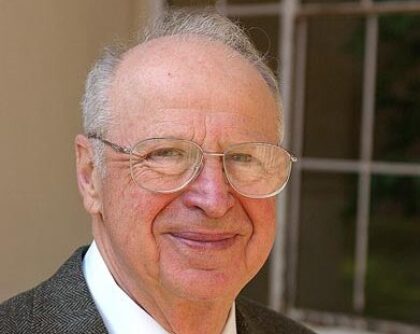George Benedek
Research Interests
The research of the Benedek group centers on phase transitions, self-assembly and aggregation of several biological molecules. These phenomena are of biological and medical interest because phase separation, self-assembly and aggregation of biological molecules are known to play a central role in several human diseases such as cataract, Alzheimer’s disease, and cholesterol gallstone formation. A combination of experimental work, theoretical analysis, and computer simulations is used to understand the connection between the basic interactions amongst the molecules and the resulting condensed phases.
Biographic Sketch
Professor George B. Benedek received his Ph.D. in Physics from Harvard University in 1953. He is now the Alfred H. Caspary Professor of Physics and Biological Physics at the MIT Department of Physics, and a member of the Faculty of the Harvard-MIT Division of Health Sciences and Technology. An experimental physicist, he has published over one hundred and sixty research papers in a variety of fields including high pressure physics, nuclear magnetic resonance, quasielastic light scattering spectroscopy, phase transitions and critical phenomena in ferromagnets, simple fluids, micelles and microemulsions. His recent work focuses on the connection between aggregation, phase separation and self-assembly of biological macromolecules and cataract disease, Alzheimer’s disease, and cholesterol gallstone formation.
He is a member of the National Academy of Sciences, the Institute of Medicine of the National Academy of Sciences, and is a Fellow of the American Academy of Arts and Sciences. He has been awarded the American Physical Society’s Irving Langmuir Prize in Chemical Physics, and the Proctor Medal of the Association for Research in Vision and Ophthalmology for his work on the theory of transparency of the cornea and the lens.
Awards & Honors
- 1997 // Association for Research in Vision and Ophthalmology's (ARVO) Proctor Medal for "outstanding research in basic or clinical sciences as applied to ophthalmology"
- 1995 // The Vinci of Excellence "Science for Art" Prize
- 1995 // Irving Langmuir Prize in Chemical Physics (APS) "For his outstanding invention of dynamic light scattering spectroscopy and its fundamental applications to critical phenomena, macromolecular transport, and ocular diseases."
- 1988 // American Academy of Arts and Sciences Member
- 1981 // National Academy of Sciences Member
- 1962 // American Physical Society Fellow
